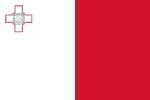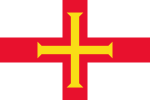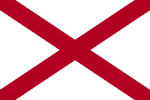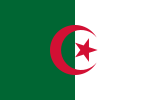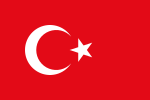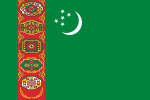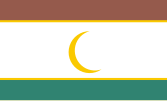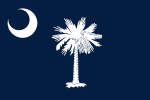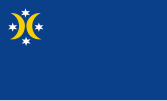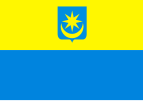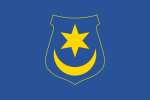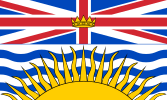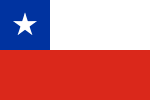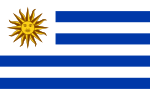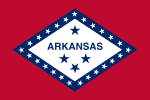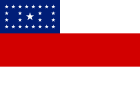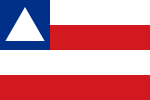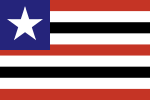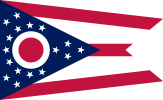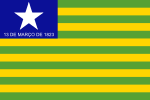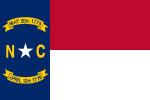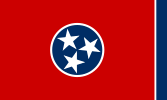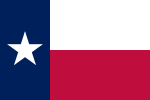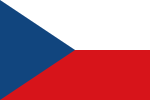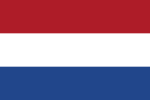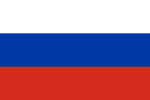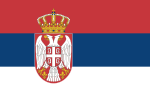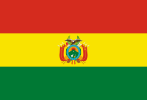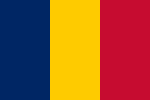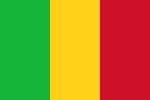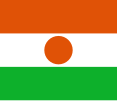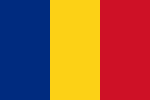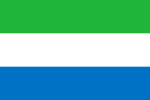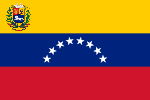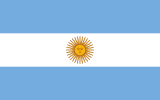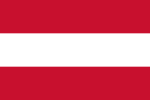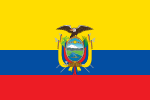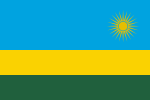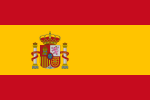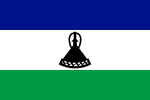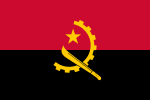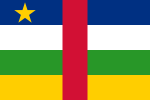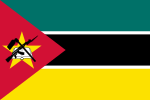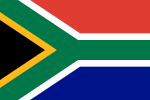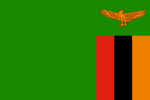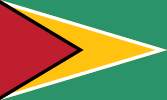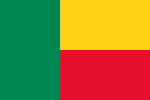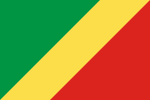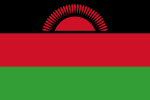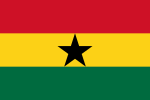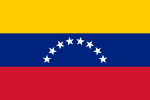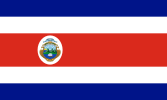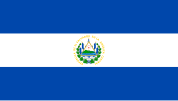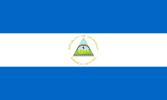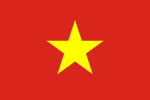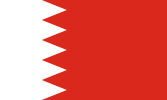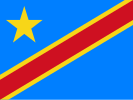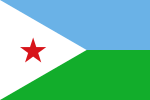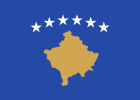Flag families

Flag families are sets of national flags with similarities in their design, often based on a shared history, culture, or influence. Families do not include flags with coincidental similarities. Flags may be in multiple flag families. Only twelve current national flags existed before the 19th century, when large-scale flag use began. Seven of these flags (Denmark, France, the Netherlands, Russia, Turkey, the United Kingdom, and the United States) are the inspiration for more than 130 current national flags and ensigns.[1]
Christian cross
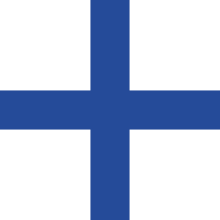
A Christian cross flag is any flag with a cross or crosses as a central element of its design (as opposed to flags like those of Malta and Serbia, which use crosses as smaller embellishments). It is the oldest flag family. The first flag purported to have such a cross was the flag of Portugal, beginning in around 1100.[2] The flag design became the most common design for merchant ships across Europe for several centuries.[3] Flags in this family use different types of crosses, including the Latin cross (†), the Greek cross (✚), and the Maltese cross (✠). (The Maltese cross does not appear on Malta's national flag, only its civil ensign.)
Nordic cross
Flags in the Nordic cross family feature crosses stretching the width and length of the flag, with the center offset to hoist. The cross design represents Christianity;[4][5][6] Denmark was the first to adopt this design in the 14th century. As the oldest national flag in continuous use,[7] the flag of Denmark served as inspiration for other Nordic countries as they adopted theirs. Though the design is strongly associated with Nordic countries, cities and territories outside the region use this design. Greenland is the only Nordic region that does not use the Nordic cross.[8]
Crescent
Flags with crescents are recorded as being used in the region of Middle East and North Africa as early as the 14th century.[9] These designs often featured a white crescent open toward the top on a solid-colored field. During the 19th century when national flags became common, the Ottoman Empire was the only Muslim state considered a world power.[10] Its flag popularized the crescent design for other Muslim nations when they later adopted flags.[3] Most Muslim crescent flags also have one or more stars near or within the circle formed by the crescent. The crescent appears on several flags of non-Muslim subnations and municipals. These crescent flags have symbolism unrelated to Islam.
- Flag of Osa Canton, Costa Rica
- Flag of Wajir County, Kenya
- Flag of Bayan-Ölgii Province, Mongolia
- Flag of Azad Kashmir (disputed territory)
- Flag of Northern Cyprus (disputed territory)
- Flag of Western Sahara (disputed territory)
- Flag of Sveti Ivan Zelina, Croatia
- Flag of Varnsdorf, Czech Republic
- Flag of Halle an der Saale, Germany
- Flag of the Metropolitan City of Milan, Italy
- Flag of Mārahau, New Zealand
- Flag of Mińsk Mazowiecki, Poland
- Flag of Tarnobrzeg, Poland
British Ensign

The British Ensign family is composed of flags with the Union Jack in the canton. The Union Flag adopted in 1606 combined the Saint George's Cross of England and the St. Andrew's saltire of Scotland to form the Union Flag.[11] The Saint Patrick's saltire was added to the flag in 1801. In the mid-19th century, the British government declared the use of a white ensign for use by the Royal Navy, a red ensign for non-government vessels, and a blue ensign for all vessels "belonging to, or permanently in, the service of the Colonies."[12] As the British Empire expanded, so too did the use of variations of the ensigns, especially the blue ensign.[3] Of the original fifty-three independent nations in the British Commonwealth, all but four had the Union Jack on their flag. Forty-four have removed the Union Jack from their flags.[13]
Stars and Stripes

The stars and stripes flag family is composed of flags of alternating stripes with a field in the hoist (often the canton) charged with an emblem (often, but not always, a star or stars). Early versions of the flag of the United States were based on ensigns of the United Kingdom, with the Union Flag on the canton. Instead of a solid-colored field, they had stripes inspired by the flag of the East India Company. In 1777, the Continental Congress of the United States resolved to replace the Union Flag with thirteen stars.[14] The first nation to adopt a similar flag was the Hawaiian Kingdom,[15] and many other nations wanting to express ideals of liberty and democracy followed suit.[3]
- Flag of Abkhazia (partially recognized republic)
- Flag of Arkansas (state of US)
- Flag of Amazonas (state of Brazil)
- Flag of Bahia (state of Brazil)
- Flag of Brittany (region of France)
- Flag of Georgia (U.S. state) (state of US)
- Flag of Goiás (state of Brazil)
- Flag of Hawaii (state of US)
- Flag of Maranhão (state of Brazil)
- Flag of Missouri (state of US)
- Flag of Ohio (state of US)
- Flag of Puerto Rico (unincorporated territory of US)
- Flag of Piauí (state of Brazil)
- Flag of North Carolina (state of US)
- Flag of Tennessee (state of US)
- Flag of Yucatán (state of Mexico)
- Flag of São Paulo (state of Brazil)
- Flag of Sergipe (state of Brazil)
- Flag of Texas (state of US)
- Flag of West Papua (proposed country)
Dutch and pan-Slavic colors

Dutch and pan-Slavic colors are a family of flags, usually with red, white, and blue stripes, inspired by the Dutch and later Russian flags. The first flag of simple stripes were the livery colors of William I, Prince of Orange, used in the mid-16th century. These stripes of orange, white, and blue became the first flag of the Netherlands.[16] In the 17th century, the orange was replaced by red.[17] Tsar Peter the Great personally designed a merchant flag of Russia based on the colors of the flag of the Netherlands.[18] The Russian flag, in turn, inspired many flags of countries in the Slavic region. Most retained the white, blue and red, but Bulgaria changed the blue stripe on the flag of Russia into a light green stripe.[19]
Tricolours and tribands

A tricolor is any flag following the flag of France in its design of three vertical stripes of equal width, each distinct in color. On the eve of the French Revolution, 13 July 1789, red and blue cockades were given to the militia of Paris. Soon afterward, Louis XVI added one to his royal white cockade.[20] These colors, arranged as stripes, became the flag of France in 1794. In this way, vertical tribands of three colors became associated with movements for republicanism and were adopted by many nations transitioning to republican governance,[3] although their use was never exclusive to such states. Unlike tricolour, the triband design may contain two identical colors, such as flags of Nigeria and Peru.
A number of triband flags have a central band that is exactly twice the width of others, a design known as Spanish fess (horizontal) or Canadian pale (vertical). On some flags, this is not the central band, such as for Colombia or Rwanda.
- Flag of Latvia (2:1:2)
- Flag of Andorra (8:9:8)
- Flag of Lesotho (3:4:3)
- Flag of Tajikistan (2:3:2)
- Flag of Mexico (1:3:1)
- Flag of Belize (1:8:1)
Pan-African
Flags in the pan-African family use a combination of some or all of the colors red, yellow, green, and black. Some pan-African flags also have white and, less commonly, blue, but these are not considered[by whom?] pan-African colors. The designs of flags in this family vary considerably. The colors red, yellow, and green became associated with pan-African colors through the Ethiopian flag.[21] Black was later added by Marcus Garvey, an activist and organizer for the first black unification movement in the United States.[22] Inspired by the pan-African colors' growing association with post-colonial independence, many countries in the Caribbean and the Guianas with large populations in the African diaspora also adopted pan-African colors.[23]
Ethiopian flag family

The colors green, yellow, and red have been historically important in Ethiopia since the early 17th century.[24] Along with Liberia, Ethiopia was the only currently existing nation to avoid European colonization during the scramble for Africa.[25] Its flag, therefore, was the inspiration for many countries that gained independence after colonization. The modern flags of Bolivia, Lithuania, and Myanmar also use these three colors, but their origins are unrelated to the Ethiopian flag.[26][27]
Marcus Garvey and Theodosia Okoh families


The Jamaican pan-Africanist leader Marcus Garvey inspired two independent sets of national African flags. In 1917, he proposed a red, black, and green flag for his organization, known as the Universal Negro Improvement Association and African Communities League.[22] According to Garvey,[28]
Red is the color of the blood which men must shed for their redemption and liberty; black is the color of the noble and distinguished race to which we belong; green is the color of the luxuriant vegetation of our Motherland.
These three colors were the inspiration behind the flag of Kenya, the flag of Malawi, the Flag of South Sudan and other historic flags such as the flag of Biafra.[29] Independently, Marcus Garvey also created the Black Star Line, a shipping company between the United States and West Africa that transported many African-Americans to Africa and vice versa.[30] The eponymous black star of the house flag of the company later became a part of three national flags in West Africa, starting with the flag of Ghana designed by Theodosia Okoh.[31][32]
Pan-Arab colors
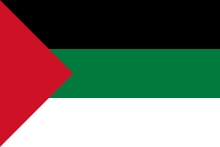

The pan-Arab flag family is a set of flags featuring three or four of the colors red, black, white, and green. The flags have three horizontal stripes, often with an emblem in the center or an overlapping shape in the hoist. According to biographers of Muhammad, he used both flags of white and flags of black.[33] Each color of the pan-Arab flags is associated with a caliphate of Islam. White and black flags were used by the Umayyad and Abbasid dynasties respectively.[34] Although green is often identified as the color of the Fatimid dynasty by vexillological sources,[35][36][37] that is not correct: their dynastic color was white.[38][39][40] Green is now considered the color of Islam.[35] Red was the color of the Hashemites.[34] These colors were also described by the 14th-century Iraqi poet Safi al-Din al-Hilli: "White are our deeds, black are our battles, green are our ranches, red are our swords."[41]
In 1911, members of a Turkish literary club chose these four colors as the colors of the modern Arabic flag.[3] The colors were combined in the flag of the Arab Revolt in 1916, and many countries adopted these colors as the colors of their national flags upon gaining independence from the Ottoman Empire at the end of World War I.[42]
- Flag of Palestine (disputed territory)
- Flag of Western Sahara (disputed territory)
Iranian colors

Iran adopted a flag with green, white, and red stripes in the mid-19th century.[43] The flag has undergone changes since, but the three stripes remain. When the newly independent republic of Tajikistan changed its flag from its former Soviet version, it chose to use the same stripes in reverse order as a nod to its close cultural ties with neighbouring Iran.[44] The flag of Kurdistan, a geo-cultural region overlapping with Iran, uses the green-white-red stripes of the Iran flag charged with a yellow sun.[citation needed]
Gran Colombia

The Gran Colombia flag family is made up of flags of countries in the South American former area of Gran Colombia. They have three horizontal stripes of yellow, blue, and red. Venezuelan revolutionary leader Francisco de Miranda personally designed the flag of Gran Colombia, a historic state that included modern Colombia, Ecuador, Panama, Venezuela, and parts of Brazil and Guyana.[45] The flag of Gran Colombia had three colours signifying Hispanic America (yellow), the Atlantic Ocean (blue), and "bloody Spain" (red).[3] Miranda attributed the inspiration for these colors to a late-night conversation with the German writer and color theorist Johann Wolfgang von Goethe, who is described as saying[46]
Yellow is the most warm, noble and closest to light ... blue is that mix of excitement and serenity, a distance that evokes shadows ... red is the exaltation of yellow and blue, the synthesis, the vanishing of light into shadow.
The flag of Gran Colombia was first hoisted in 1806. It led to the current designs of Colombia, Ecuador, and Venezuela.[3]
Belgrano

The Belgrano flag family is composed of flags of Central and South America with blue and white stripes. In 1812, the Argentine revolutionary general Manuel Belgrano raised a flag in Rosario, Argentina, of three horizontal stripes of blue-white-blue. It was formally adopted by the Government of Argentina in 1816.[47] Six years later, commander-general of El Salvador Manuel José Arce took the "Argentine colours of Belgrano" as a new national flag of that province, becoming the first additional flag of the family.[3][48] Building on this, the flag of the Federal Republic of Central America had blue and white stripes, and all of the countries that were once part of that republic retain those stripes in some way in their flags. El Salvador and Nicaragua have also retained the triangular emblem of the former republic; the flag of Costa Rica has an additional red stripe. Argentina's and Uruguay's flags now have the Sol de Mayo.[3]
Red banner
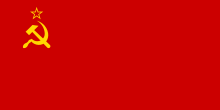
The red banner flag family is the family of flags that use large red fields or red stars as symbols of communism. The color red became associated with revolution when it was adopted by the Jacobins during the early days of the French Revolution as a symbol of their willingness to shed blood for their cause.[49] After being used by the Paris Commune in 1871, the color became closely associated with socialism.[50] The Bolsheviks used these flags as inspiration during the Russian Revolution, adopting the flag of the Soviet Union upon their victory in 1922. As a result, the color red became more closely associated with communism than socialism.[51] The flag also featured a hammer and sickle and a red star fimbriated by gold, two symbols that also became closely associated with communism. As communism spread during the 20th century, many countries, especially in Asia and Africa, adopted red flags and stars to symbolize their support for the political movement. Every former Soviet state once flew red banners.[52] All but Belarus, which simply removed the traditional communist hammer and sickle, has adopted a different flag since the fall of the Soviet Union. Similarly, the current flag of Mongolia removed the communist star from its flag in 1992, but kept all of the other elements.[53]
- Flag of Transnistria (disputed territory)
Trucial States
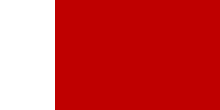
Trucial State flags are a flag family from the southern and eastern coasts of the Persian Gulf. They consist of red flags with white stripes, cantons, or borders. Red is a traditional color of the Kharijite Muslims who lived in this region, and they historically used all-red banners.[54] It was the British who added the white to the flags of the region. When the region became a British protectorate in 1820, the treaty drafted by the United Kingdom said[55]
the friendly Arabs shall carry by land and sea a red flag, with or without letters in it, at their option, and this shall be in a border of white...
Instead of borders, most of the states adopted a stripe. Nearly all of these states are now member emirates of the United Arab Emirates. While the flag of the United Arab Emirates is not a Trucial States flag, the flags of the individual member emirates still are. In the 1930s, the independent countries within the Trucial State flag family, Bahrain and Qatar, both adopted serrated edges from their earlier straight-edge designs.[56] The flag of Qatar is unique in the Trucial State flag family for having a darker shade of red or maroon, a color made using traditional shell-based dye from the area.[57]
United Nations
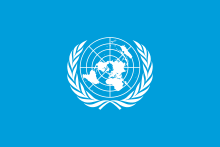
The United Nations flag family includes the flag of the United Nations and subsequent flags that borrowed design elements from the flag including the colors, symbols, or both. The UN adopted its emblem and flag in 1947.[58] The flag came to represent the neutrality and cooperation of the UN, so similar flags are often adopted for regions in states of conflict or instability. The first such national flag was the flag of Eritrea from 1952 to 1962, which symbolized peace between the Christians and Muslims in the newly formed country.[3] The current Eritrean national flag, adopted in 1993, has less of the UN blue, but still retains the UN olive branches from the first design.[59] The flag of Cyprus, adopted 1960, has no UN blue, but has the laurel wreath and a map as the central emblem.[60] Most national flags inspired by the UN's were flags of United Nations trust territories, colonies that transitioned to independence with support and administration from the UN. These include the flag of the Trust Territory of the Pacific Islands (which later inspired the flags of Micronesia and the Northern Mariana Islands) the flag of the Trust Territory of Somaliland (which is the design of the current flag of Somalia), and the Flag of the United Nations Transitional Authority in Cambodia (which was replaced by the current flag of Cambodia that is not in the UN flag family).[61]
References
- ^ Znamierowski, Alfred (2013). The World Encyclopedia of Flags: The Definitive Guide to International Flags, Banners, Standards, and Ensigns, with Over 1400 Illustration. Lorenz Books. p. 100. ISBN 978-0-7548-2629-3.
...flag use did not develop on a large scale until the 19th Century and continued during the 20th Century. Out of some 195 independent countries, only 12 have flags whose designs were adopted before 1800. Seven of these (Denmark, Great Britain, the Netherlands, Russia, the United States, France and Turkey) have influenced the designs and colors of over 130 national flags and ensigns...
- ^ "AMT - Bandeiras de Portugal". 2007-02-25. Archived from the original on 2007-02-25. Retrieved 2022-10-23.
- ^ a b c d e f g h i j k Znamierowski, Alfred (2013). The World Encyclopedia of Flags: The Definitive Guide to International Flags, Banners, Standards, and Ensigns, with Over 1400 Illustration. Lorenz Books. pp. 100–129. ISBN 978-0-7548-2629-3.
- ^ Jeroen Temperman (2010). State Religion Relationships and Human Rights Law: Towards a Right to Religiously Neutral Governance. Martinus Nijhoff Publishers. p. 88. ISBN 978-9004181489. Retrieved 31 December 2007.
Many predominantly Christian states show a cross, symbolising Christianity, on their national flag. The so-called Scandinavian crosses or Nordic crosses on the flags of the Nordic countries–Denmark, Finland, Iceland, Norway and Sweden–also represent Christianity.
- ^ Carol A. Foley (1996). The Australian Flag: Colonial Relic or Contemporary Icon. William Gaunt & Sons. ISBN 9781862871885. Retrieved 31 December 2007.
The Christian cross, for instance, is one of the oldest and most widely used symbols in the world, and many European countries, such as the United Kingdom, Norway, Sweden, Finland, Denmark, Iceland, Greece and Switzerland, adopted and currently retain the Christian cross on their national flags.
- ^ Andrew Evans (2008). Iceland. Bradt. ISBN 9781841622156. Retrieved 31 December 2007.
Legend states that a red cloth with the white cross simply fell from the sky in the middle of the 13th-century Battle of Valdemar, after which the Danes were victorious. As a badge of divine right, Denmark flew its cross in the other Scandinavian countries it ruled and as each nation gained independence, they incorporated the Christian symbol.
- ^ "Oldest continuously used national flag". Guinness World Records. Retrieved 2022-10-23.
- ^ "The Greenland flag in the capital Nuk, Greenland | GRID-Arendal". www.grida.no. Retrieved 2022-11-05.
- ^ Masood, Hassan. The History and Symbolic Meaning of Crescent.
- ^ "The Great Powers and the 'Eastern Question'". staff.lib.msu.edu. Retrieved 2022-10-23.
- ^ Fox-Davies, Arthur Charles (1904). The art of heraldry : an encyclopædia of armory. Boston Public Library. London : T.C. & E.C. Jack.
- ^ Weekes, Nick (10 June 2008). "Colonial Flag Badges: A Chronology" (PDF). The Flag Institute. 2: 2.
- ^ Mulholland, Malcolm (2016). "New Zealand Flag Fats". natlib.govt.nz. p. 49. Retrieved 2022-10-23.
- ^ "Resolved, That the flag of the United States..." postalmuseum.si.edu. Retrieved 2022-10-23.
- ^ Marshall, Tim (2017-07-04). A Flag Worth Dying For: The Power and Politics of National Symbols. Simon and Schuster. pp. 52–53. ISBN 978-1-5011-6833-8.
- ^ Rey, Jean (1837). Histoire du drapeau, des couleurs et des insignes de la Monarchie française, précédée de l'histoire des enseignes militaires chez les anciens (in French). Techener. p. 515.
- ^ Eriksen, Thomas Hylland; Jenkins, Richard (2007-10-18). Flag, Nation and Symbolism in Europe and America. Routledge. p. 23. ISBN 978-1-134-06696-4.
- ^ Massie, Robert K. (2012). Peter the Great. Vol. 160 (Modern Library ed.).
- ^ "Bulgaria: Flag". The World Factbook. Central Intelligence Agency. Retrieved 2022-11-14.
- ^ "The French flag". elysee.fr. 2015-10-21. Retrieved 2022-10-24.
- ^ Shelby, Tommie (2003). "Two Conceptions of Black Nationalism". Political Theory. 31 (5): 664–692. doi:10.1177/0090591703252826. S2CID 145600053.
- ^ a b "On Flag Day, Remembering The Red, Black And Green". NPR.org. Retrieved 2022-10-24.
- ^ "All the Flags of the Caribbean and the Meaning Behind Their Designs". Matador Network. Retrieved 2022-10-24.
- ^ Flag Bulletin. Flag Research Center. 1988.
- ^ "Countries in Africa Considered Never Colonized". ThoughtCo. Retrieved 2022-10-24.
- ^ Ordóñez, Micaela Sanjines (2022-08-17). "Día de la Bandera: Homenaje e historia de la 'Tricolor'". Bolivia.com (in Spanish). Retrieved 2022-11-05.
- ^ "The Lithuanian State flag". lrs.lt. Retrieved 2022-11-05.
- ^ McGuire, George Alexander; Harvey, Thomas W.; Universal Negro Improvement Association (1921). Universal Negro catechism: a course of instruction in religious and historical knowledge pertaining to the race. New York: Universal Negro Improvement Association.
- ^ "The Pan-African flag started as response to bigotry — It became an enduring symbol". FOX 5 Atlanta. 2020-02-19. Retrieved 2022-10-24.
- ^ Moore, Jay E. (2021-02-27). "Marcus Garvey's Black Star Line". The Mariners' Museum and Park. Retrieved 2022-10-24.
- ^ Znamierowski, Alfred (2013). The World Encyclopedia of Flags: The Definitive Guide to International Flags, Banners, Standards and Ensigns, with Over 1400 Illustration. Lorenz Books. p. 124. ISBN 978-0-7548-2629-3.
In 1957, Ghana became the first independent country in western Africa to adopt a flag in these colours. Its flag, in the Ethiopian colors with a black star, was inspired by the flag of the Black Star Line shipping company established by Garvey in Accra.
- ^ "Theodosia Salome Okoh: Designer of the Ghana Flag". Ghanaian Museum. 2020-06-13. Archived from the original on 2022-10-24. Retrieved 2022-10-24.
- ^ Cook, David (1966). Studies in Muslim apocalyptic. p. 6. Retrieved 2022-10-24 – via Internet Archive.
- ^ a b "Saudi Aramco World: Flags of the Arab World". archive.aramcoworld.com. Retrieved 2022-10-24.
- ^ a b Beam, Christopher (2009-06-09). "Why is the color green so important in the Muslim world?". Slate. Retrieved 2022-10-24.
- ^ Znamierowski, Alfred (2013). The World Encyclopedia of Flags: The Definitive Guide to International Flags, Banners, Standards and Ensigns, with Over 1400 Illustration. Lorenz Books. p. 122. ISBN 978-0-7548-2629-3.
- ^ "Saudi Aramco World: Flags of the Arab World". archive.aramcoworld.com. Retrieved 2022-10-29.
- ^ Hathaway, Jane (2003). A Tale of Two Factions: Myth, Memory, and Identity in Ottoman Egypt and Yemen. Albany, New York: State University of New York Press. p. 97. ISBN 978-0-7914-5883-9.
The Ismaili Shi'ite counter-caliphate founded by the Fatimids took white as its dynastic color, creating a visual contrast to the Abbasid enemy.
- ^ Blair, Sheila S.; Bloom, Jonathan M. (1999). "Art and Architecture: Themes and Variations". In Esposito, John L. (ed.). The Oxford History of Islam. Oxford: Oxford University Press. pp. 215–267. ISBN 0-19-510799-3.
...white was also the color associated with the Fatimid caliphs, the opponents of the Abbasids.
- ^ Sanders, Paula A. (1994). Ritual, Politics, and the City in Fatimid Cairo. SUNY Series in Medieval Middle East History. SUNY Press. p. 44. ISBN 0-7914-1781-6.
...wore white (the Fatimid color) while delivering the sermon (khuṭba) in the name of the Fatimid caliph.
- ^ "The Flag – protocol-en". protocol.gov.iq. Archived from the original on 2022-10-23. Retrieved 2022-10-24.
- ^ Friedman, Isaiah (2011-12-31). British Pan-Arab Policy, 1915-1922. Transaction Publishers. p. 135. ISBN 978-1-4128-1514-7.
- ^ "Iranian Flag, A Brief History (English version)" (PDF). 2011-07-26. Archived from the original (PDF) on 2011-07-26. Retrieved 2022-10-24.
- ^ "Tajikistan". www.fotw.info. Retrieved 2022-10-23.
- ^ "Los nombres de Colombia". 2016-09-18. Archived from the original on 2016-09-18. Retrieved 2022-10-23.
- ^ Smith-Mesa, Vladimir A. ""...A Place Where Primary Colours Are Not Distorted" (Goethe, Francisco de Miranda and the Theory of Colours". Academia.
- ^ "Flag of Argentina - History of Argentina Flag - don Quijote". www.donquijote.org. Retrieved 2022-10-24.
- ^ "flag of El Salvador | Britannica". www.britannica.com. Retrieved 2022-10-24.
- ^ "Red Flag". Age of Revolution. Retrieved 2022-10-24.
- ^ "The Paris Commune 1871: Cannon, The Red Flag and Balloons over Montmartre". Montmartre Artists' Studios. Retrieved 2022-10-24.
- ^ "flag of Union of Soviet Socialist Republics | Britannica". www.britannica.com. Retrieved 2022-10-24.
- ^ "Emblems and Flags of the Soviet Republics". soviettours.com. 12 January 2021. Retrieved 2022-10-24.
- ^ "flag of Mongolia | Britannica". www.britannica.com. Retrieved 2022-10-26.
- ^ Smith, Whitney (1976). Flags through the Ages and across the World. McGraw Hill. p. 274.
- ^ Treaty. Peace and Friendship. [Also known as the General Maritime Treaty]. 8 January 1820.
- ^ Publishing, D. K. (2009-01-06). Complete Flags of the World. Penguin. ISBN 978-0-7566-5486-3.
- ^ "Qatar Flag History | Qatar National Day Organizing Committee". Organizing Committee for Qatar National Day Celebrations. Retrieved 2022-10-24.
- ^ "United Nations Emblem and Flag". United Nations. Retrieved 2022-10-24.
- ^ "National Flag: Precious National Symbol". Eritrea Ministry of Information. 17 October 2020. Retrieved 2022-10-24.
- ^ "Presidency of the Republic of Cyprus - The Flag". 2017-01-26. Archived from the original on 2017-01-26. Retrieved 2022-10-24.
- ^ Library, Dag Hammarskjöld. "Research Guides: UN Trusteeship Council Documentation: Trust Territories". research.un.org. Retrieved 2022-10-24.





